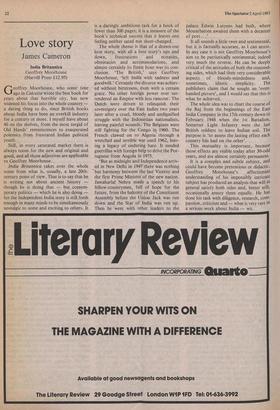Love story
James Cameron
India Britannica Geoffrey Moorhouse (Harvill Press £12.95)
Geoffrey Moorhouse, who some time ago in Calcutta wrote the best book for years about that horrible city, has now widened his focus into the whole country — a daring thing to do, since British books about India have been an overkill industry for a century or more. I myself have about 40 on the shelves, from the most turgid of Old Hands' reminiscences to exasperated polemics from frustrated Indian political youth.
Still, in every saturated market there is always room for the new and original and good, and all those adjectives are applicable to Geoffrey Moorhouse.
India Britannica takes over the whole scene from what is, usually, a late 20th- century point of view. That is to say that he is writing not about ancient history — though he is doing that — but contem- porary politics — which he is also doing — for the Independent India story is still fresh enough in many minds to be simultaneously nostalgic to some and exciting to others. It
is a daringly ambitious task for a book of fewer than 300 pages; it is a measure of the book's technical success that it leaves one feeling neither sated nor short-changed.
The whole theme is that of a drawn-out love story, with all a love story's ups and down, frustrations and ecstasies, obstinacies and accommodations, and almost certainly its finest hour was its con- clusion. 'The British,' says Geoffrey Moorhouse, 'left India with sadness and goodwill.' Certainly the divorce was achiev- ed without bitterness, even with a certain grace. No other foreign power ever sur- rendered an Empire with less rancour. The Dutch were driven to relinquish their sovereignty over the East Indies two years later after a cruel, bloody and undignified struggle with the Indonesian nationalists, leaving painful wounds. The Belgians were still fighting for the Congo in 1960. The French clawed on to Algeria through a wretched and terrible war until 1962, leav- ing a legacy of enduring hate. It needed guerrillas with foreign help to drive the Por- tuguese from Angola in 1975.
'But as midnight and Independence arriv- ed in New Delhi in 1947 there was nothing but harmony between the last Viceroy and the first Prime Minister of the new nation. Jawaharlal Nehru made a speech to his fellow-countrymen, full of hope for the future, from the balcony of the Constituent Assembly before the Union Jack was run down and the Star of India was run up. Then he went with other leaders to the palace Edwin Lutyens had built, where Mountbatten awaited them with a decanter of port ...'
It all sounds a little twee and sentimental, but it is factually accurate, as I can attest. In any case it is not Geoffrey Moorhouse's aim to be patriotically sentimental; indeed very much the reverse. He can be deeply critical of the attitudes of both the contend- ing sides, which had their very considerable aspects of bloody-mindedness and, sometimes, idiotic simplicity. The publishers claim that he sought an 'even- handed picture', and I would say that this is what he achieved.
The whole idea was to chart the course of the Raj from the beginnings of the East India Company in the 17th century down to February 1948 when the 1st Battalion, Somerset Light Infantry were the last British soldiers to leave Indian soil. The purpose is 'to assess the lasting effect each country has had on the other'.
This mutuality is important, because those effects are visible today after 30-odd years, and are almost certainly permanent.
It is a complex and subtle subject, and could have become pretentious or didactic.
Geoffrey Moorhouse's affectionate understanding of his impossibly intricate subject has produced an analysis that will In general satisfy both sides and, better still, occasionally annoy them equally. He has done his task with diligence, research, com- passion, criticism and — what is very rare in a serious work about India — wit.






































 Previous page
Previous page